Oct. 22 to Oct. 28
For many years, the battle was called “The Great Victory at Guningtou” (古寧頭大捷). At that time, the Chinese Communist Party had already established the People’s Republic of China in Beijing and were hell bent on wiping out the Chinese Nationalist Party (KMT) troops remaining in China’s southern areas.
On Oct. 17, 1949, the People’s Liberation Army (PLA) captured Xiamen. Kinmen, just a few kilometers off shore, was next, and ultimately, Taiwan.
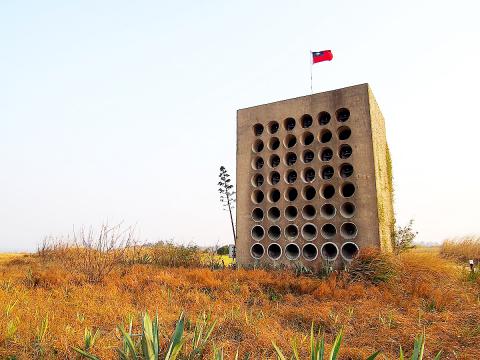
Photo courtesy of Wikimedia Commons
On the evening of Oct. 24, about 20,000 PLA soldiers left the shores of Xiamen in wooden boats, with about 9,000 landing on Kinmen. After three days of intense fighting, all soldiers who landed were captured or killed, resulting in a rare victory for the KMT. It is seen as a significant event in cross-strait relations, in which the KMT not only safeguarded Kinmen, but also stopped the PLA from advancing on to Taiwan.
When KMT leader Chiang Kai-shek (蔣介石) heard the news, he shed tears of relief, stating, “Taiwan is safe … This is the turning point of our revolution.” Taiwan Provincial Governor Chen Cheng (陳誠) visited Kinmen the day after the victory and made the following speech: “This great victory … is the beginning of our military success in the southeast and has given our people a boost in morale after so much losing … Upon hearing the news, the people of Taiwan all celebrated joyfully, as this event bodes a bright future for our country.”
The KMT had barely won any battles since the PLA crossed the Yangtze River in January 1949. How were they able to rally in the most crucial moment?
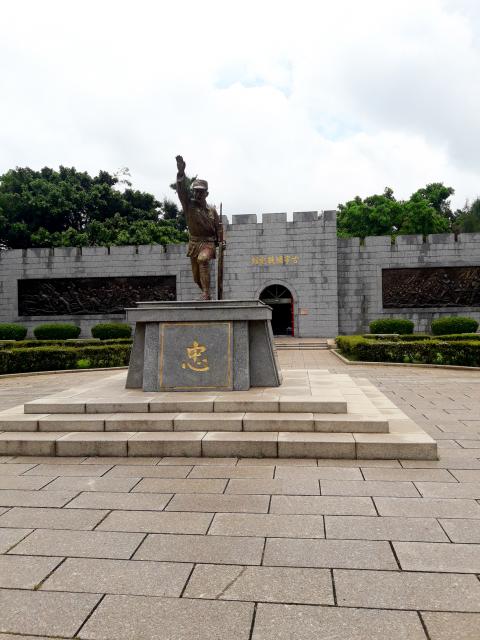
Photo courtesy of Wikimedia Commons
COMMANDER’S WORDS
The late General Hu Lien (胡璉), who participated in the Battle of Guningtou, published a book in the 1970s detailing the victory.
He is quoted to have said in a Legislative Yuan meeting in 1974, “In 25 years, the Communists have wanted to attack Kinmen and Taiwan, but they don’t have the ability to, nor do they dare. Some people think the Communists are hesitant because of international pressure, but I think that’s a secondary reason. They’re afraid of the anti-Communist fortress we have established in Kinmen, Penghu and Taiwan … I’m confident to say that the day the Communist bandits attack, it will be the beginning of the end for them.”
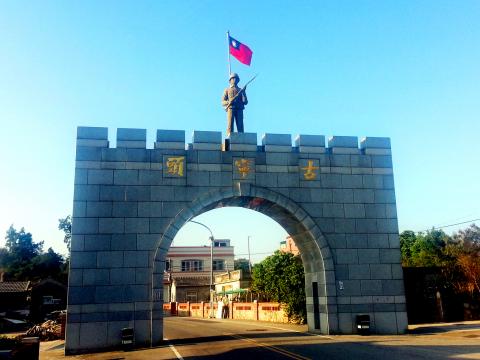
Photo courtesy of Wikimedia Commons
This speech falls in line with the traditional stance that the KMT espoused in its early days, when it still believed that it could retake China one day.
Hu and his 12th Brigade arrived on Kinmen at dusk on Oct. 25, only to find out that the PLA invasion was already under way. The KMT troops had rushed the PLA troops while they disembarked their ships, capturing many enemies, cutting off their escape routes and burning the boats so they couldn’t escape. Things stagnated later that day, but Hu’s arrival greatly bolstered the KMT forces as they continued the onslaught throughout the 26th.
By the morning of the 27th, the KMT had cleared out the PLA troops in Guningtou Village, and the remaining soldiers along the shore surrendered. Chen Cheng arrived in Kinmen later that day, upon which several hundred more PLA troops appeared out of the bushes and to surrender.
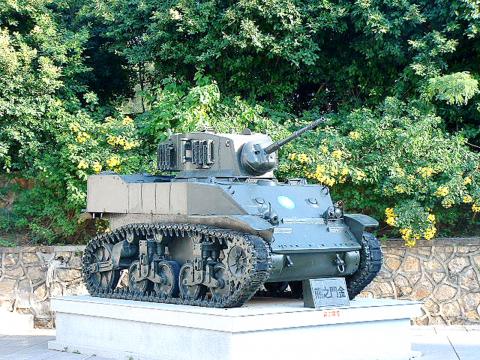
Photo courtesy of Wikimedia Commons
“The mistakes of the enemy gave us a chance to quickly assemble an army for a chance to win,” Hu begins his analysis of the battle.
He writes that if the PLA troops cleared out the KMT troops on the southern coast of China first, then the KMT would not have been able to send any reinforcements to Kinmen. If they attacked any earlier or any later, it would have been a surefire Communist victory.
But Hu writes that the Communists were too impatient. Instead of a more tactical invasion with troops landing at multiple points on the island, they decided to send in 9,000 troops without a commanding officer overseeing the entire operation.
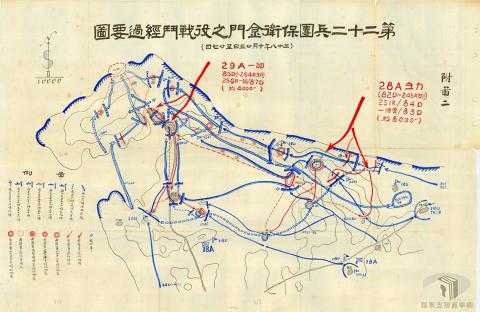
Photo courtesy of Archival Resources for Teaching, National Archives Administration
Meanwhile, Hu lauds the KMT for keeping their troops supplied and in high morale amidst all the losing, and prepared for the invasion by deploying a large force to Kinmen while other battles were going on. He also praises the two commanders who held on to Kinmen before his arrival, noting that if they wavered, the PLA would still be able to win despite their miscalculations.
Finally, he credits the ROC Navy and Air Force for taking out PLA cannons and disrupting their ability to send reinforcements to Kinmen.
Outspoken former PLA general Liu Yazhou (劉亞洲) agrees with Hu on many points, writing in a paper on the topic, “If we attacked three days earlier, we would have been able to rout the KMT forces before Hu could arrive. If we attacked three days later, we would have known about Hu’s arrival and had a chance to reevaluate our strategy.”
According to the PLA’s official report released on Oct. 29, 1949, the main reasons for their crushing defeat was “rashness of the plan and underestimation of the enemy.”
MODERN TAKES FROM BOTH SIDES
A government report published on the 60th anniversary of the battle revisits the decisive factors: Chiang’s foresight in April 1949 to fortify the previously undefended Kinmen; Chen Cheng’s timely resolution to send in the 12th Brigade; KMT troops holding out in Xiamen long enough to fortify Kinmen, the high morale and fighting spirit of the troops and correct tactical decisions of the commanders; and finally the strong KMT (US supplied) artillery and tanks as well as the previously mentioned help from the Air Force and Navy.
The report finds the Communists “wildly overconfident” after winning almost every fight that year. They did not plan carefully how reinforcements would arrive from Xiamen, greatly underestimating the number of KMT troops in Kinmen. The PLA had originally planned to invade Kinmen two weeks earlier, but the operation kept being delayed due to difficulty gathering boats.
Finally, since the area around Guningtou was indeed the best point to disembark, the KMT was already waiting there and was able to deal a heavy blow to the enemy just as they arrived.
A new book on the battle by Chinese scholars does mention the tactical errors by the PLA, but it also points to several “coincidences” that contributed to the KMT victory. The authors write that the PLA troops were actually about to complete a convert landing operation when a KMT scout accidentally set off a landmine, which quickly led to the KMT troops discovering the invasion.
Also, three malfunctioning tanks left by the shore “suddenly started working again” as the PLA troops arrived, boosting the KMT’s firepower on the beach.
But the authors acknowledge that even with these coincidences, the KMT still took this battle much more seriously than the Communists. They compared the battle to Qing Dynasty Admiral Shih Lang (施琅) taking Taiwan in 1662, noting that not only were conditions acting in his favor, but he was also well-prepared.
“Without sufficient preparation, no number of ‘coincidences’ would be of use,” they conclude.
Taiwan in Time, a column about Taiwan’s history that is published every Sunday, spotlights important or interesting events around the nation that have anniversaries this week.

April 14 to April 20 In March 1947, Sising Katadrepan urged the government to drop the “high mountain people” (高山族) designation for Indigenous Taiwanese and refer to them as “Taiwan people” (台灣族). He considered the term derogatory, arguing that it made them sound like animals. The Taiwan Provincial Government agreed to stop using the term, stating that Indigenous Taiwanese suffered all sorts of discrimination and oppression under the Japanese and were forced to live in the mountains as outsiders to society. Now, under the new regime, they would be seen as equals, thus they should be henceforth

Last week, the the National Immigration Agency (NIA) told the legislature that more than 10,000 naturalized Taiwanese citizens from the People’s Republic of China (PRC) risked having their citizenship revoked if they failed to provide proof that they had renounced their Chinese household registration within the next three months. Renunciation is required under the Act Governing Relations Between the People of the Taiwan Area and the Mainland Area (臺灣地區與大陸地區人民關係條例), as amended in 2004, though it was only a legal requirement after 2000. Prior to that, it had been only an administrative requirement since the Nationality Act (國籍法) was established in

Three big changes have transformed the landscape of Taiwan’s local patronage factions: Increasing Democratic Progressive Party (DPP) involvement, rising new factions and the Chinese Nationalist Party’s (KMT) significantly weakened control. GREEN FACTIONS It is said that “south of the Zhuoshui River (濁水溪), there is no blue-green divide,” meaning that from Yunlin County south there is no difference between KMT and DPP politicians. This is not always true, but there is more than a grain of truth to it. Traditionally, DPP factions are viewed as national entities, with their primary function to secure plum positions in the party and government. This is not unusual

US President Donald Trump’s bid to take back control of the Panama Canal has put his counterpart Jose Raul Mulino in a difficult position and revived fears in the Central American country that US military bases will return. After Trump vowed to reclaim the interoceanic waterway from Chinese influence, US Defense Secretary Pete Hegseth signed an agreement with the Mulino administration last week for the US to deploy troops in areas adjacent to the canal. For more than two decades, after handing over control of the strategically vital waterway to Panama in 1999 and dismantling the bases that protected it, Washington has